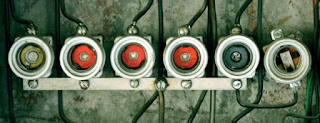Electrical Systems Insurance 60 Amp Service
Electrical Systems Insurance 60 Amp Service
60 Amp Service - More and more frequently insurance companies are refusing to insure homes with 60 amp services, knob and tube wiring, and in some cases, even aluminum wiring. Does this mean these types of components or systems are categorically dangerous? No. Like all electrical components, they can be dangerous is they do not meet certain minimum requirements, but they can also be as safe as any others.
 |
| insurance 60 amp service |
The Consumer Division of the Insurance Bureau of Canada operates an information line at 1-800-387-2880 that can answer some questions with respect to how to obtain insurance on homes equipped with 60 amp services, knob & tube and aluminum wiring.
60 Amp Services
Most standard sized homes built prior to the 1960's were equipped with a 60 amp electrical service. This size of service was reasonably well suited to the needs of living at the time. However, the search for convenience and enhanced lifestyle has generally increased the demand on the electrical systems of homes today.
A common misunderstanding is that the ampacity (size, or capacity) of a home's electrical service is determined by checking the main breaker or fuses or the rating imprinted on the panel. This method of determining size is fraught with problems as the ratings of breakers, fuses and panels may correlate to the size of the electrical service, but in many cases they don't. The panel could have been upgraded without upgrading the service wires.
Electric Service Entry
The size of an electrical service is established by the ampacity (capacity) of the incoming service wires. The only reliable method of determining the size of the service is to observe and correctly identify the size of the incoming wires and the related equipment (mast, meter base, etc.).
It is becoming a common belief that electrical services less than 100 amps are inadequate, therefore unsafe and therefore, they must be upgraded. Smaller electrical services, such as 60 amps a not necessarily unsafe and are not categorically inadequate. A 60 amp service will however, limit the number of appliances that can be used at any one time.
For safey and practical purposes the adequacy of an electrical service should be judged against the size of the potential or expected load it will be required to carry. To some degree the load is determined by the size and number of circuits in the home and by the size of the home.
One indication of a service that is undersized for the demands applied to it is the blowing or popping of the main fuses or breaker switch. If the main fuses or breaker is affected, the service is probably undersized. If the service is undersized for the current demands, increasing the size of the service is one option; an alternative is to reduce the quantity of heavy loads such as the oven, clothes dryer or water heater. Central air-conditioners also draw heavy current and the installation of one may require the upgrading of the electrical service.
Another common belief is that if an individual circuit breaker pops or a fuse blows on a regular basis, the service requires upgrading. Problems with individual circuit breakers or fuses indicate only that the circuit involved has a problem and most likely, it is more heavily loaded than it was designed to be. A service upgrade would not necessarily solve this problem. What is probably needed is to reduce the load on the affected circuit, possibly by introducing another circuit into the area where it's needed.
"Knob & Tube" Wiring
Knob & tube wiring is a type of wiring which was in common use until the 1940's and sometimes used as late as the 1950's. The nick-name is derived from the ceramic knobs that are employed to insulate and secure the wiring runs and the ceramic tubes employed to protect the wires where they pass through potentially abrasive materials (primarily wood joists, studs etc.) Unlike subsequent wiring systems where all the wires in a run are enclosed in a cable, the two wires (black/hot and white/neutral) run separately and only come together at a terminal (switch, receptacle, fixture, junction box etc.).
Knob & Tube Wiring
Knob & tube wiring does not provide a third wire for grounding and is therefore considered unsafe in kitchens, bathrooms, laundry rooms and outdoors. In other areas, knob & tube wiring that is in good condition with sheathing intact, properly protected from damage, and that hasn't been subjected to extended periods of overloading which can cause it to become brittle, should not pose an increased safety risk.
Aside from the preceding concerns, the primary risk with knob & tube wiring, it seems, is it's relative accessibility for amateur repairs, upgrades and maintenance. It is not uncommon to see a system with knob & tube wiring that has a history of amateur work (poorly joined connections, unfastened runs, unprotected wires, etc.). If a house does have knob & tube wiring wiring it should be inspected to ensure that it is properly installed and in good condition.
Note: Many older homes with originally installed knob & tube wiring have had some of the wiring upgraded. While modern wiring is visible in many areas, much of the knob & tube wiring may still be in place and concealed beneath floors, above ceilings and hehind walls.
If a few, but not all, of the circuits are in poor condition they can be replaced eventually without rewiring the whole house. However, if most or all of the circuits are in poor condition, it may be more economical to completely rewire the home. Rewiring can also allow the electrical system to be more convenient as the new circuits can be designed to accommodate the present lifestyle of the occupants of the home.
Article Source: http://EzineArticles.com/99693
What's up, just wanted to say, I liked this blog post.
ReplyDeleteIt was funny. Keep on posting!